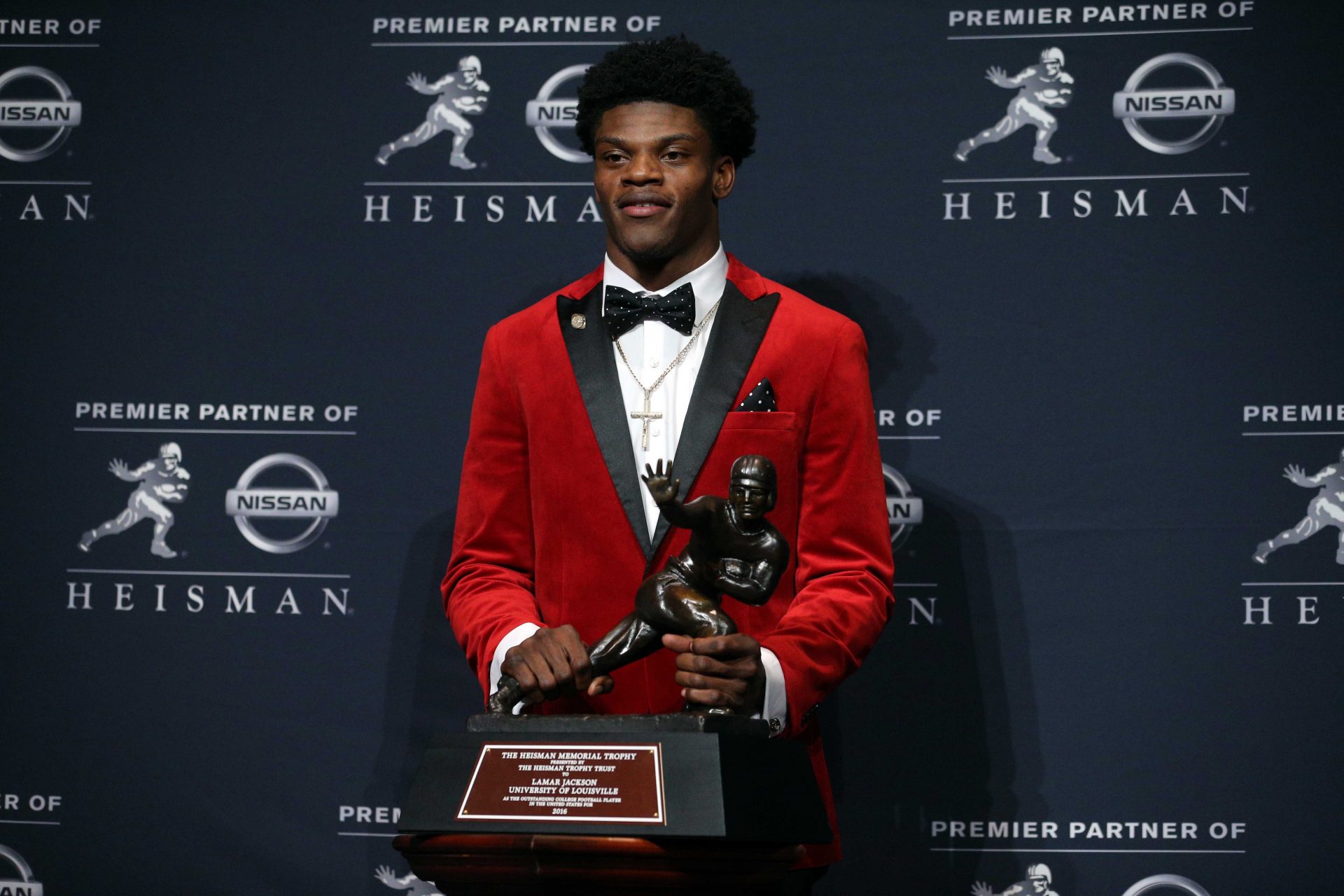There are heroes in every college football season. However, only one can grasp the Heisman Trophy—the sport’s most coveted individual honor. And although bluebloods such as Alabama and USC have trophy rooms full of Heismans, Louisville did something in 2016 that no one had ever done.
A teenage phenom with lightning in his cleats made the trophy seem tailor-made for him. His name? Lamar Jackson is the most dynamic dual-threat quarterback the game has witnessed in years.
Let’s turn back the clock and explore Louisville’s historic moment and the unforgettable cast of characters who made 2016 one of the craziest and most talent-laden Heisman races in history.

Lamar Jackson (Louisville—Heisman Winner, 2016)
When Lamar Jackson took the field for Louisville in 2016, it didn’t take long for college football to know—it was different. Just 19 years old, Jackson had defenders missing so spectacularly that it seemed someone was operating a joystick. That year, he produced video game-like statistics: 3,543 passing yards, 30 passing touchdowns, and a preposterous 1,571 rushing yards with 21 more touchdowns.
He became the youngest Heisman winner in history and the first Louisville player, cementing his status as more than a star but a full-fledged cultural phenomenon. His iconic Heisman pose following a 63–20 rout of Florida State remains seared in the memory of every college football enthusiast.
“It’s crazy, man. I’m still in shock,” Jackson said, holding back tears during his Heisman speech. “I just wanted to play ball. And now, I’m here.”
Jackson wasn’t merely a stat machine; he revolutionized the game. He took the Louisville Cardinals national and redefined what a quarterback should be. The “Lamar Effect” became a reality, and NFL teams noticed. Jackson became the 2019 NFL MVP with the Baltimore Ravens, demonstrating his Heisman wasn’t hype—it was prophecy.
Deshaun Watson (Clemson—Heisman Runner-Up, 2016)
While Lamar was burning up defenses, Deshaun Watson was busy elsewhere at Clemson—i.e., winning football games and rewriting Tigers lore. In 2016, Watson accumulated 4,593 passing yards and 41 touchdowns, with another nine scores on the ground. He wasn’t merely piling up stats; he was taking Clemson to a national championship.
Watson came in second in the Heisman voting that season. Still, he got the last laugh after guiding a last-minute drive to defeat Alabama in the National Championship Game. Legendary coach Dabo Swinney put it best: “Deshaun Watson is the best player in college football. Period.”
Although not a Louisville player, Watson’s influence helped shape the 2016 Heisman campaign—and set the bar for what quarterbacks should do.
Baker Mayfield (Oklahoma—Finalist, 2016; Winner, 2017)
Baker Mayfield was the wild card—bold, brash, and outspoken. The Oklahoma Sooner was a finalist in 2016 with 3,965 passing yards and 40 touchdowns, throwing almost 71% of his attempts well. He didn’t take it home that year, but it wasn’t finished yet.
Mayfield returned in 2017 with a vengeance, passing for more than 4,600 yards and 43 touchdowns. His swaggering attitude, walk-on-to-Heisman path, and legendary “plant-the-flag” ceremony at Ohio State made him a college football folk hero.
“I’ve been doubted my entire life,” Mayfield said. “Winning this shows that dreams exist when you grind for them.”
From Heisman finalist to NFL No. 1 draft pick, Mayfield became a contemporary icon of determination—and a key figure in Jackson’s record-breaking win season.
Jabrill Peppers (Michigan—Finalist, 2016)
If versatility had a face in 2016, it would have been Jabrill Peppers. Michigan’s do-everything machine manned linebacker, safety, running back, and even quarterback snaps. His line? 72 tackles, four sacks, a rushing touchdown, and a game-breaking punt return touchdown.
He wasn’t merely a player—he was a Swiss Army knife with shoulder pads. Peppers’ placement on the Heisman ballot (a feat rarely achieved by a defensive player) resonated with Charles Woodson’s 1997 victory and reminded voters that impact isn’t always quantified in passing yards.
“Wherever they need me, I go,” Peppers said. “I’m a football player, not just a position.”
Even though he didn’t win, his finalist position showed how special teams and game-breaking defense can still be worthy of Heisman recognition.
Dede Westbrook (Oklahoma—Finalist, 2016)
Finally, Dede Westbrook ensured wide receivers were not left out in 2016’s Heisman discussion. With 1,524 receiving yards and 17 touchdowns, the Oklahoma speedster was virtually unstoppable to cover.
He caught an average of 19.1 yards per reception and converted ordinary slants into highlight-reel dashes. Westbrook was Mayfield’s ace in the hole and a significant reason the Sooners were a top offensive threat. While receivers don’t usually win the Heisman, Dede’s finalist appearance reminded everyone: when you’re this good, you must be in the room.
Why 2016 Still Stands Out?
The 2016 Heisman campaign wasn’t merely Jackson’s debut but a fireworks display of top-shelf talent. It was an epic battle between Jackson’s record-breaking campaign, Watson’s title chase, Mayfield’s showmanship, Peppers’ defensive magic, and Westbrook’s deep-ball mastery.
KEEP READING: Miami Hurricanes Heisman Trophy Winners: A Complete List and History
And although only a single player may win the award, Louisville’s Lamar Jackson ensured it was never forgotten, not only for the school but also for college football. The Cardinals have been attempting to recapture that high since then, trying to find another talent to keep pace with the magic 8.
Jackson’s Heisman victory was not just about numbers. It was about timing, showmanship, and convincing the world that a boy from Pompano Beach, Florida, could write new pages in the record books and place Louisville football in the national spotlight.
College Sports Network has you covered with the latest news, analysis, insights, and trending stories in college football, men’s college basketball, women’s college basketball, and college baseball!

